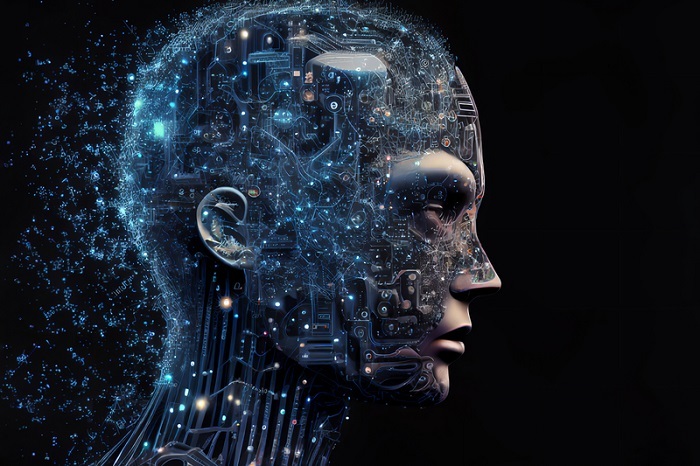
 Data Structure
Data Structure Networking
Networking RDBMS
RDBMS Operating System
Operating System Java
Java MS Excel
MS Excel iOS
iOS HTML
HTML CSS
CSS Android
Android Python
Python C Programming
C Programming C++
C++ C#
C# MongoDB
MongoDB MySQL
MySQL Javascript
Javascript PHP
PHP
- Selected Reading
- UPSC IAS Exams Notes
- Developer's Best Practices
- Questions and Answers
- Effective Resume Writing
- HR Interview Questions
- Computer Glossary
- Who is Who
How Companies Are Using AI in Digital Marketing?
Although the term "artificial intelligence," or AI, may seem contradictory, it is really making our society intelligent by automating business processes, developing technological innovations, and increasing productivity. AI, once material of speculative fiction, is already beginning to subtly influence our daily lives.

Consider commuting as an illustration. We undoubtedly have some time for transportation if you travel to work. By providing real-time data to visualization software to account for traffic, renovation, and tragedies, AI is assisting in shortening commute times. AI is assisting in ensuring the best service for those who utilize public transportation. Also, AI makes it possible for you to use a taxi service like Uber or OLA by anticipating pick-up timings.
The only typical example is the workplace. If you depend on Voice recognition, Google, gmail, Youtube, Twitter, Ebay, Snapchat, Netflix, Google play music, and the myriad other tools on which we have grown to count, you will also encounter AI on a regular basis. Indeed, AI is present in all areas.
Corporations may employ AI in one of two methods that will improve their digital marketing. One is located on the backend where businesses employ AI to predict consumer demand for their products, develop customer identities, carry out programmatic ad purchasing, and other similar tasks. The other is the consumer-facing side, where marketing departments employ AI to improve the client experience, ultimately enhancing the image and generating revenue. In fact, according to 70% of firms utilizing AI and machine learning, these technologies increase consumer experience by more than 10%.
Use of AI in Digital Marketing by Companies

Organizations are utilizing AI in digital marketing in a number of ways to increase consumer happiness, including ?
1. Virtual assistants and chatbots
Virtual assistants and chatbots are computer codes created to mimic human beings in communication. In order to comprehend and reply to customer inquiries, give out information, or carry out activities, they employ machine learning (ML) and natural language processing (NLP) techniques.
Typically, chatbots are included in web pages, websites that use social media, and messaging services to offer consumers immediate guidance and support. They can respond to routinely asked inquiries, offer marketing materials, and even start operations like reservations or sales.
Virtual assistants, on the opposite end, are created to carry out more complex operations and are frequently audio. Amongst many other things, they might stream songs, operate intelligent home gadgets, and calendar events and reminders. Amazon's Alexa, Voice Recognition, and Google's new Siri are a few examples of well-known virtual assistants.
Companies are gradually using chatbots and voice assistants because they can boost customer service by providing round-the-clock help without the requirement for interpersonal interactions. By performing similar processes, they may also preserve both time and cash and free up human employees to work on more difficult and valuable jobs.
However, creating efficient automation and robo - advisors calls for thorough preparation and configuration, which would include characterizing the bot's purpose, selecting the user experience, and figuring out how to have a dialogue. Finally, the bot must be trained to comprehend customer requests and offer precise and pertinent answers.
2. Voice Search Optimization

Voice Search Optimization: Well with the growing popularity of virtual assistants like Google Home, Amazon Echo, and Alexa, businesses are also making their information more voice search-friendly. Businesses may provide material that AI systems can find more readily by utilizing speech recognition and many other AI approaches, which will enhance the consumer experience.
Increasing a website's performance and performance for speech-based search inquiries is a practice known as voice keyword research. Voice search has gained popularity as a method of web-based information search due to the rising popularity of virtual assistants like Amazon Alexa, Android Auto, and Apple Homepod. Voice search queries, in contrast to conventional content search, are frequently lengthier and more conversational in style. People frequently ask inquiries and utilize speech recognition when doing so.
Businesses should concentrate on producing content that satisfies particular queries and gives pertinent information in a conversational manner if they want to be voice search optimized. Use of human speech that is similar to how consumers communicate and lengthy keywords are part of this. Although many voice inquiries are conducted on portable apps, organizations should also ensure that their websites adapt to screen sizes and load rapidly.
Additional voice search optimization strategies comprise metasearch improvement by providing position characteristics in the content and utilizing relational database markup to aid search engines in comprehending the meaning of the content.
3. Image Recognition Technology

Artificial intelligence (AI) image identification technology allows robots to detect and recognize different humans, and other features inside digital videos and photographs. Technology for face recognition is another name for it.
Algorithms and algorithms for machine learning are used in the technology to evaluate sensory information, spot trends, and categorize pictures into various groups. Image capture, picture pre-processing, extraction and classification, and machine vision are just a few of the processing phases that are involved.
There are many uses for imaging recognition technology, from security-related facial recognition systems to automated vehicles that can recognize and react to traffic signs and other elements. It's additionally employed in medicine for health picture evaluation and in e-commerce for individual products.
The two major methods for recognizing images are supervised learning and unsupervised learning. In supervised learning, an algorithm for machine learning is taught to detect certain features and behaviors using labeled photos. Unsupervised learning trains the algorithm for identifying links and connections in unidentified pictures.
The past few years have seen considerable advancement in image recognition technology, and as the field develops, so do the solutions that may be used. It has grown to be an increasingly essential instrument for companies and institutions aiming to automate operations, increase productivity, and enhance client experiences due to its capacity to handle enormous volumes of visual input fast and reliably.
4. Predictive and Targeted Content
Artificial intelligence (AI) predictive and targeted resources refer to the implementation of the combination of machine learning and artificial intelligence (ML) technologies to evaluate huge amounts of information and anticipate the material that's going to be most relevant and interesting to certain consumers.
In order to forecast what consumers will likely desire or need in the coming future, predictive content analyzes information pertaining to user choices, behavior, and the result of the effects of content, product, or services using machine learning models. It may be used to provide tailored information to specific users, also including articles, movies, or product suggestions.
On the opposing side, targeted content is producing material that is explicitly created to appeal to a public customer or population according to their preferences, behavior, or other variables.
Conclusion
In conclusion, businesses have started using artificial intelligence (AI) more frequently lately in digital marketing. AI has been utilized to increase client satisfaction, reduce repetitive operations, and boost the overall efficacy of digital marketing efforts through chatbots, virtual assistants, visual recognition, and predictive content.
While using AI in digital marketing has numerous advantages, it's crucial for businesses to proceed with caution and consideration. Productive Intelligent systems involve careful development and planning, which comprises following the platform's scope, choosing the interfaces and conversational flow, and teaching the algorithm to comprehend and effectively address human demands and requests.

